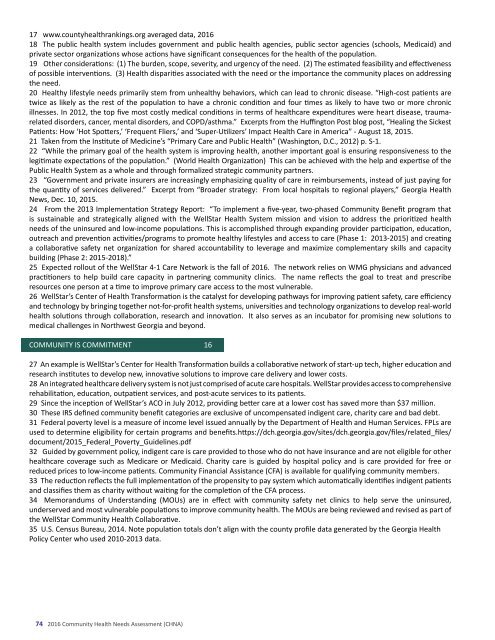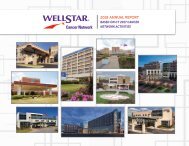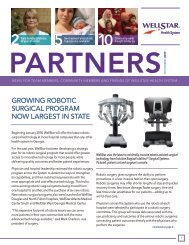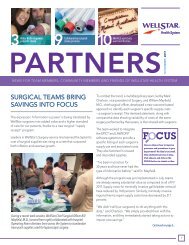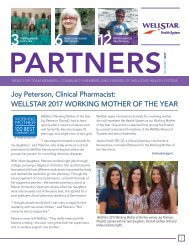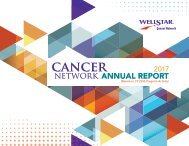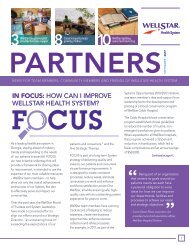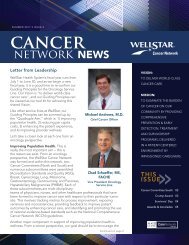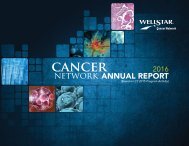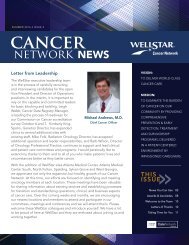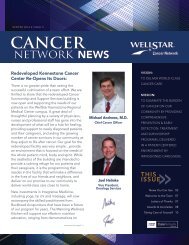WELLSTAR_CHNA_REPORT_2016
Create successful ePaper yourself
Turn your PDF publications into a flip-book with our unique Google optimized e-Paper software.
COMMUNITY IS CARE<br />
17 www.countyhealthrankings.org averaged data, <strong>2016</strong><br />
18 The public health system includes government and public health agencies, public sector agencies (schools, Medicaid) and<br />
private sector organizations whose actions have significant consequences for the health of the population.<br />
19 Other considerations: (1) The burden, scope, severity, and urgency of the need. (2) The estimated feasibility and effectiveness<br />
of possible interventions. (3) Health disparities associated with the need or the importance the community places on addressing<br />
the need.<br />
20 Healthy lifestyle needs primarily stem from unhealthy behaviors, which can lead to chronic disease. “High-cost patients are<br />
twice as likely as the rest of the population to have a chronic condition and four times as likely to have two or more chronic<br />
illnesses. In 2012, the top five most costly medical conditions in terms of healthcare expenditures were heart disease, traumarelated<br />
disorders, cancer, mental disorders, and COPD/asthma.” Excerpts from the Huffington Post blog post, “Healing the Sickest<br />
Patients: How ‘Hot Spotters,’ ‘Frequent Fliers,’ and ‘Super-Utilizers’ Impact Health Care in America” - August 18, 2015.<br />
21 Taken from the Institute of Medicine’s “Primary Care and Public Health” (Washington, D.C., 2012) p. S-1.<br />
22 “While the primary goal of the health system is improving health, another important goal is ensuring responsiveness to the<br />
legitimate expectations of the population.” (World Health Organization) This can be achieved with the help and expertise of the<br />
Public Health System as a whole and through formalized strategic community partners.<br />
23 “Government and private insurers are increasingly emphasizing quality of care in reimbursements, instead of just paying for<br />
the quantity of services delivered.” Excerpt from “Broader strategy: From local hospitals to regional players,” Georgia Health<br />
News, Dec. 10, 2015.<br />
24 From the 2013 Implementation Strategy Report: “To implement a five-year, two-phased Community Benefit program that<br />
is sustainable and strategically aligned with the WellStar Health System mission and vision to address the prioritized health<br />
needs of the uninsured and low-income populations. This is accomplished through expanding provider participation, education,<br />
outreach and prevention activities/programs to promote healthy lifestyles and access to care (Phase 1: 2013-2015) and creating<br />
a collaborative safety net organization for shared accountability to leverage and maximize complementary skills and capacity<br />
building (Phase 2: 2015-2018).”<br />
25 Expected rollout of the WellStar 4-1 Care Network is the fall of <strong>2016</strong>. The network relies on WMG physicians and advanced<br />
practitioners to help build care capacity in partnering community clinics. The name reflects the goal to treat and prescribe<br />
resources one person at a time to improve primary care access to the most vulnerable.<br />
26 WellStar’s Center of Health Transformation is the catalyst for developing pathways for improving patient safety, care efficiency<br />
and technology by bringing together not-for-profit health systems, universities and technology organizations to develop real-world<br />
health solutions through collaboration, research and innovation. It also serves as an incubator for promising new solutions to<br />
medical challenges in Northwest Georgia and beyond.<br />
COMMUNITY IS COMMITMENT 16<br />
27 An example is WellStar’s Center for Health Transformation builds a collaborative network of start-up tech, higher education and<br />
research institutes to develop new, innovative solutions to improve care delivery and lower costs.<br />
28 An integrated healthcare delivery system is not just comprised of acute care hospitals. WellStar provides access to comprehensive<br />
rehabilitation, education, outpatient services, and post-acute services to its patients.<br />
29 Since the inception of WellStar’s ACO in July 2012, providing better care at a lower cost has saved more than $37 million.<br />
30 These IRS defined community benefit categories are exclusive of uncompensated indigent care, charity care and bad debt.<br />
31 Federal poverty level is a measure of income level issued annually by the Department of Health and Human Services. FPLs are<br />
used to determine eligibility for certain programs and benefits.https://dch.georgia.gov/sites/dch.georgia.gov/files/related_files/<br />
document/2015_Federal_Poverty_Guidelines.pdf<br />
32 Guided by government policy, indigent care is care provided to those who do not have insurance and are not eligible for other<br />
healthcare coverage such as Medicare or Medicaid. Charity care is guided by hospital policy and is care provided for free or<br />
reduced prices to low-income patients. Community Financial Assistance (CFA) is available for qualifying community members.<br />
33 The reduction reflects the full implementation of the propensity to pay system which automatically identifies indigent patients<br />
and classifies them as charity without waiting for the completion of the CFA process.<br />
34 Memorandums of Understanding (MOUs) are in effect with community safety net clinics to help serve the uninsured,<br />
underserved and most vulnerable populations to improve community health. The MOUs are being reviewed and revised as part of<br />
the WellStar Community Health Collaborative.<br />
35 U.S. Census Bureau, 2014. Note population totals don’t align with the county profile data generated by the Georgia Health<br />
Policy Center who used 2010-2013 data.<br />
74 <strong>2016</strong> Community Health Needs Assessment (<strong>CHNA</strong>)


